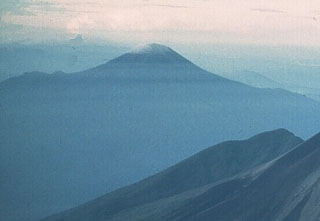Report on Bamus (Papua New Guinea) — September 2006
Bulletin of the Global Volcanism Network, vol. 31, no. 9 (September 2006)
Managing Editor: Richard Wunderman.
Bamus (Papua New Guinea) Forceful vapor emission seen on 12 July 2006
Please cite this report as:
Global Volcanism Program, 2006. Report on Bamus (Papua New Guinea) (Wunderman, R., ed.). Bulletin of the Global Volcanism Network, 31:9. Smithsonian Institution. https://doi.org/10.5479/si.GVP.BGVN200609-252110
Bamus
Papua New Guinea
5.2°S, 151.23°E; summit elev. 2248 m
All times are local (unless otherwise noted)
According to the Papua New Guinea Department of Mining (DOM), reports coming from Bialla Local Level Government (LLG) indicated that Bamus showed signs of unusual activity. At 1010 on 12 July 2006 observers saw white vapor coming out at the summit. The emission was forceful at about 1110 that day, with a tint of gray color in the emission. The vapor-rich plume blew inland to the SSE. No ashfall was reported.
Officials from Bialla LLG together with a DOM observer witnessed the activity, as did Max Benjamin from Walindi Resort (~ 40-50 km away). Benjamin called the Rabaul Volcano Observatory to report the activity. No satellite-detected thermal anomalies at the volcano were reported by the MODIS website for this time frame.
Geological Summary. Symmetrical Bamus volcano, also referred to locally as the South Son, is located SW of Ulawun volcano, known as the Father. The andesitic stratovolcano is covered in rainforest and contains a breached summit crater filled with a lava dome. There is a cone on the southern flank, and a prominent 1.5-km-wide crater with two small adjacent cones halfway up the SE flank. Young pyroclastic-flow deposits are found on the flanks, and residents describe an eruption that took place during the late 19th century.
Information Contacts: Steve Saunders and Herman Patia, Rabaul Volcanological Observatory (RVO), Department of Mining, Private Mail Bag, Port Moresby Post Office, National Capitol District, Papua, New Guinea.

